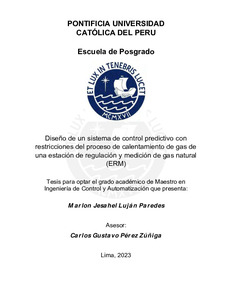| dc.contributor.advisor | Pérez Zúñiga, Carlos Gustavo | es_ES |
| dc.contributor.author | Luján Paredes, Marlon Jesahel | |
| dc.date.accessioned | 2024-02-21T00:52:55Z | |
| dc.date.available | 2024-02-21T00:52:55Z | |
| dc.date.created | 2023 | |
| dc.date.issued | 2024-02-20 | |
| dc.identifier.uri | http://hdl.handle.net/20.500.12404/27142 | |
| dc.description.abstract | El proyecto Camisea descubierto en la década del 80 tuvo que esperar casi 20 años
para el inicio de su operación comercial 2004, arribando por primera vez a Lima y
Callao, y propagándose en la actualidad a las regiones norte y sur de nuestro país,
así como al extranjero mediando buques de gas natural licuado.
Con los años gracias a Camisea ha variado la matriz eléctrica nacional, siendo este
yacimiento desde el 2011 fuente de más del 30% de energía eléctrica producida y
consumida por el Perú, generando trabajo, y mejores condiciones de vida de
millones de peruanos.
Se estudia en este trabajo la problemática del calentamiento de gas que
precisamente es entregado a una generadora eléctrica, el cual por sus niveles de
presión recibida requiere una reducción de presión que infiere inherentemente a una
reducción de temperatura por el efecto Joule-Thompson, razón por la cual es
necesario controlar esta variable de temperatura a niveles óptimos de operación, en
la estación de regulación y medición de gas natural (ERM).
Se identificó el sistema de calentamiento de gas natural el cual tiene un tiempo de
establecimiento muy alto a lazo abierto (361 minutos) que puede controlarse en lazo
cerrado usando un controlador GPC sin restricciones (17 minutos).
Se diseño una nueva estructura teórica del control predictivo basado en modelo de
forma ampliada que permite explicar cómo los horizontes de predicción y control
interactúan entre el modelo, optimizador, y la planta.
Se propone un nuevo método de sintonización de todos los parámetros de un
controlador GPC logrando optimizar la respuesta de la planta.
Se desarrolla analíticamente el método de implementación del controlador GPC sin
restricciones en un PLC, logrando definir las estrategias y consideraciones de
programación que se deben seguir para su implementación en un futuro trabajo a
corto plazo de la solución. Ante esto se concluye que la estrategia de control
avanzado es implementable en un PLC comercial. | es_ES |
| dc.description.abstract | The Camisea project discovered in the 1980s had to wait almost 20 years for the
start of its commercial operation in 2004, reaching Lima and Callao for the first time,
and currently extending to the northern and southern regions of our country, as well
as the abroad through liquefied natural gas vessels.
Over the years, thanks to Camisea, the national electrical matrix has changed, since
2011 this deposit has been the source of more than 30% of the electrical energy
produced and consumed by Peru, generating work and better living conditions for
millions of Peruvians.
This thesis studies the problem of gas heating that is precisely delivered to an electric
generator, which due to its received pressure levels requires a pressure reduction
that inherently infers a temperature reduction due to the Joule-Thompson effect,
reason why which is necessary to control this temperature variable at optimal levels
of operation, in the natural gas regulation and measurement station (ERM).
The natural gas heating system was identified which has a very high open-loop
settling time (361 minutes) that can be controlled in closed-loop using a GPC
controller without restrictions (17 minutes).
A new theoretical structure of model-based predictive control was designed in an
expanded way that allows explaining how the prediction and control horizons interact
between the model, the optimizer, and the plant.
A new method of tuning of all the parameters of a GPC controller is proposed,
optimizing the response of the plant.
The implementation method of the GPC controller without restrictions in a PLC is
analytically developed, managing to define the strategies and programming
considerations that must be followed for its implementation in a future short-term
work of the solution. Given this, it is concluded that the advanced control strategy
can be implemented in a commercial PLC. | es_ES |
| dc.language.iso | spa | es_ES |
| dc.publisher | Pontificia Universidad Católica del Perú | es_ES |
| dc.rights | info:eu-repo/semantics/openAccess | es_ES |
| dc.rights.uri | http://creativecommons.org/licenses/by/2.5/pe/ | * |
| dc.subject | Gas natural--Regulación | es_ES |
| dc.subject | Gas natural--Medidas de seguridad | es_ES |
| dc.title | Diseño de un sistema de control predictivo con restricciones del proceso de calentamiento de gas de una estación de regulación y medición de gas natural (ERM) | es_ES |
| dc.type | info:eu-repo/semantics/masterThesis | es_ES |
| thesis.degree.name | Maestro en Ingeniería de Control y Automatización | es_ES |
| thesis.degree.level | Maestría | es_ES |
| thesis.degree.grantor | Pontificia Universidad Católica del Perú. Escuela de Posgrado. | es_ES |
| thesis.degree.discipline | Ingeniería de Control y Automatización | es_ES |
| renati.advisor.dni | 41864666 | |
| renati.advisor.orcid | https://orcid.org/0000-0001-5946-1395 | es_ES |
| renati.author.dni | 44511993 | |
| renati.discipline | 712037 | es_ES |
| renati.juror | Tafur Sotelo, Julio Cesar | es_ES |
| renati.juror | Perez Zuñiga, Carlos Gustavo | es_ES |
| renati.juror | Moran Cardenas, Antonio Manuel | es_ES |
| renati.level | https://purl.org/pe-repo/renati/level#maestro | es_ES |
| renati.type | https://purl.org/pe-repo/renati/type#tesis | es_ES |
| dc.publisher.country | PE | es_ES |
| dc.subject.ocde | https://purl.org/pe-repo/ocde/ford#2.00.00 | es_ES |







